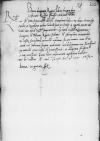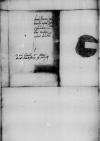[Reverendo in Christo Patri], domino ⌊Ioanni Dan[tisco episcopo Cu]lmensi⌋, apud ⌊sacram [caesaream et] catholicam maiestatem⌋ [regio ac no]stro oratori [sincere] nobis dilecto
⌊Bona⌋ Dei gratia regina ⌊Poloniae⌋, magna dux ⌊Lithuaniae⌋, ⌊Russiae⌋, ⌊Prussiae⌋, ⌊Masoviae⌋ etc. domina
Reverende in Christo Pater, sincere nobis dilecte.
Accepimus litteras Strenuitatis
Tuae datas 16 mensis Aprilis ex ⌊Ratisbona⌋, quibus labores suos perscribit in negotio ⌊Montis nostri Serici⌋, tam apud serenissimum ⌊imperatorem⌋, quam apud serenissimum ⌊Romanorum, Hungariae et Bohemiae regem⌋ habitos et exemplum memorialis rei nostrae huiusmodi porrecti vidimus. In quo omnia vera et ex animi nostri sententia scripta probamus nec dubitamus rem successuram ex voto nostro, cum iusta et promissa sit, si diligentia et opera Strenuitatis
Tuae accesserit, quam brevi experimento cognoscere licebit. Et bene valeat Paternitas Vestra.
⌊Cracoviae⌋, die 5 Maii 1532.
⌊Bona⌋ regina subscripsit

